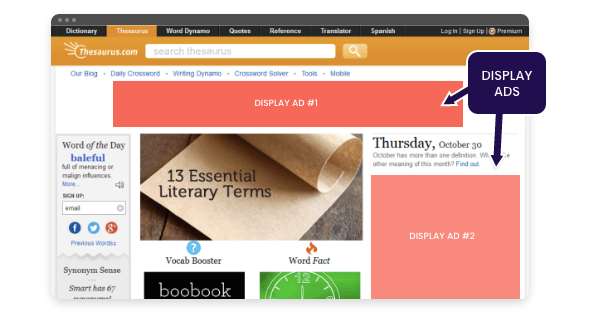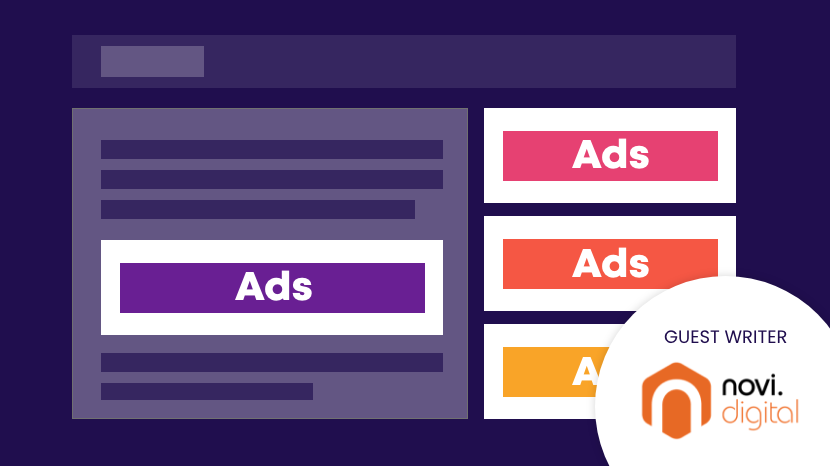When it comes to getting the right results from marketing spends, small to medium businesses (SMBs) usually find themselves under a lot more pressure than larger corporations. Smaller marketing budgets mean it can be more difficult to experiment with different advertising campaigns, which makes developing a successful digital marketing strategy even more important. In this article, we’re going to focus on how display advertising can play a crucial role in your pay-per-click (PPC) campaign, and how it can help SMBs generate new revenue streams.
What is display advertising?
Display advertising broadly refers to a means of advertising products or services via visuals. These visuals can be images or videos which can also incorporate company logos, text and animations. Most of us have seen display advertising before, even if we haven’t realised it.
There are several distinct types of display advertising: banner ads, onsite ads and mobile popups are all forms of display advertising. Most display adverts are square or rectangular in shape and contain content designed to align with the website hosting them, combined with selected audience preferences.

Digital display advertising is almost as old as the concept of the internet itself. The first digital display advertisement was uploaded to the internet in October 1994 to promote an internet service provider. Since then, display advertising has evolved – not just from a design perspective, but in terms of the volume of digital display ads that internet users see.
Nowadays, digital advertising campaigns can be run through PPC advertising networks such as Google ads, or via social media advertising. These platforms can provide SMEs with powerful audience targeting features as well as a variety of different advertising formats which can be combined with digital display ads.
What are the Types of Digital Display Advertising?
Display advertising can vary hugely in terms of who a campaign is designed to target, and how the campaign itself works. Here is a brief breakdown of the different display advertising options available to marketers, and how they work:
Remarketing ads
Many of the PPC display ads we see across search engines and social media are remarketing ads. The trend toward personalisation of marketing means that remarketing campaigns are now widespread.
According to research by Accenture, over 90% of consumers prefer to purchase from brands that remember their needs and interests, and those that provide tailored offers based on what they like. Remarketing ads do exactly that, and here’s how they work:
· A small section of code is embedded into your company website. This code collects information related to the browsing behaviour of your customers/prospects (such as how and when they navigate from category and product pages).
· The information collected can be used to develop and segment lists of customer types based on what sort of advertising messages would be most likely to appeal to them.
· You can then create display advertising based on the different categories of consumers you have observed.

Contextually targeted display advertising
Instead of showing your digital display advertising to people based on their user profile, contextually targeted advertising is displayed based on certain criteria including:
- The topic/keywords of your ad
- Language
- Location
- The overarching theme of the host website
- The browsing history of the host website’s recent visitors
Personalised display ads
Search engines like Google consider remarketing ads to be a subcategory of personalised display ads. Personalised ads are designed to target consumers based on demographics including the interests they have shown online. These parameters can be tweaked to ensure your campaign targets a specific audience.
There are four distinct types of personalised advertising. Each of these targets general user preferences and behaviour as opposed to the interactions an individual has had with a particular brand. These four personalised ad types are:
- Affinity targeting: PPC ads are displayed to consumers who demonstrate an active interest in your market.
- Custom affinity: these target smaller niches within a larger market, such as “horror movie fans” or “long distance runners” as opposed to movie fans or runners in general.
- Custom intent: these adverts target consumers who are actively searching for products/services that you offer.
- Similar audience: these ads target people who have characteristics or interests which cross over with your existing users. PPC advertising companies like Google Ads compare profiles of the users on your remarketing list with other users and identify any commonalities, before offering these adverts based on similarity.
Site-placed display advertising
Site-placed advertising, also known as website placement targeting, is when you custom hand-pick the websites you’d like to host your ads. This can be combined with contextual targeting, where you allow your PPC platform to select the most relevant sites for your ads to be displayed.
What are the benefits of display advertising?
Digital display advertising is an incredibly powerful marketing tool for small-medium enterprises. This is because:
Display advertising attracts attention
The ability to bring eye-catching custom designs and styles to display advertising means it will always stand out in comparison to regular text-only PPC ads. Display advertising, graphics, video, audio and animation all help to attract the attention of potential customers.

Display ads help cement brand awareness
To attract new customers, your prospects need to be made aware that your brand exists. Some studies suggest that consumers need to encounter a brand between seven and ten times before they consider doing business with them. Display advertising allows you to get in front of prospective consumers before they need specific goods or services from you.
Display ads allow you to retarget those who are interested in your products
Retargeting allows you to deliver digital display advertising to consumers based on their previous online behaviour. This can include previous visitors to your website who didn’t make it all the way down the conversion funnel. Retargeting works because the demographic you’re displaying adverts to has already demonstrated an interest in your products or services, and can go that extra mile to help seal the deal.
Display ads help you conquer the competition
This might sound a little devious, but digital display ads are a great way to interrupt consumers who are about to do business with your competitors. Using retargeting, you can put your display ads in front of consumers who have browsed products similar to yours on a competitor’s website. You can then offer them a great deal on the same product via your display ads, thereby winning new customers – and crucially, taking them away from the competition.
Display advertising helps you reach on-the-go consumers
While this tactic is only really applicable if you have a bricks-and-mortar presence (for example, if you run a restaurant or operate as a high street retailer), it can be useful in shoring up footfall to your premises. The technique is called geofencing and involves setting up a virtual perimeter in a geographic area within your PPC platform. From here, you can push display ads in the form of deals and offers (such as a two-for-one meal deal) to the smartphone of anybody who passes through your geofenced area. This can be useful to grab the attention of new consumers in the area, as well as entice old customers back with a targeted offer.
How can display advertising be used as part of a digital marketing strategy?
You should consider display advertising as part of your digital marketing strategy because:
- It is visually appealing to consumers
- It helps increase visibility
- It helps develop brand awareness
- It targets customers who are already interested in your products
- It can be easily tracked and analysed to ensure you are getting a good ROI
- It complements your existing marketing strategies (such as SEO and PPC)
Even if PPC and SEO are your main drivers of traffic and conversions, display advertising can function incredibly successfully as a means to develop brand awareness. From raising the awareness among prospective customers to tempting repeat purchasers with targeted offers and deals, display advertising is an intelligent tactic at every juncture of the customer journey.




